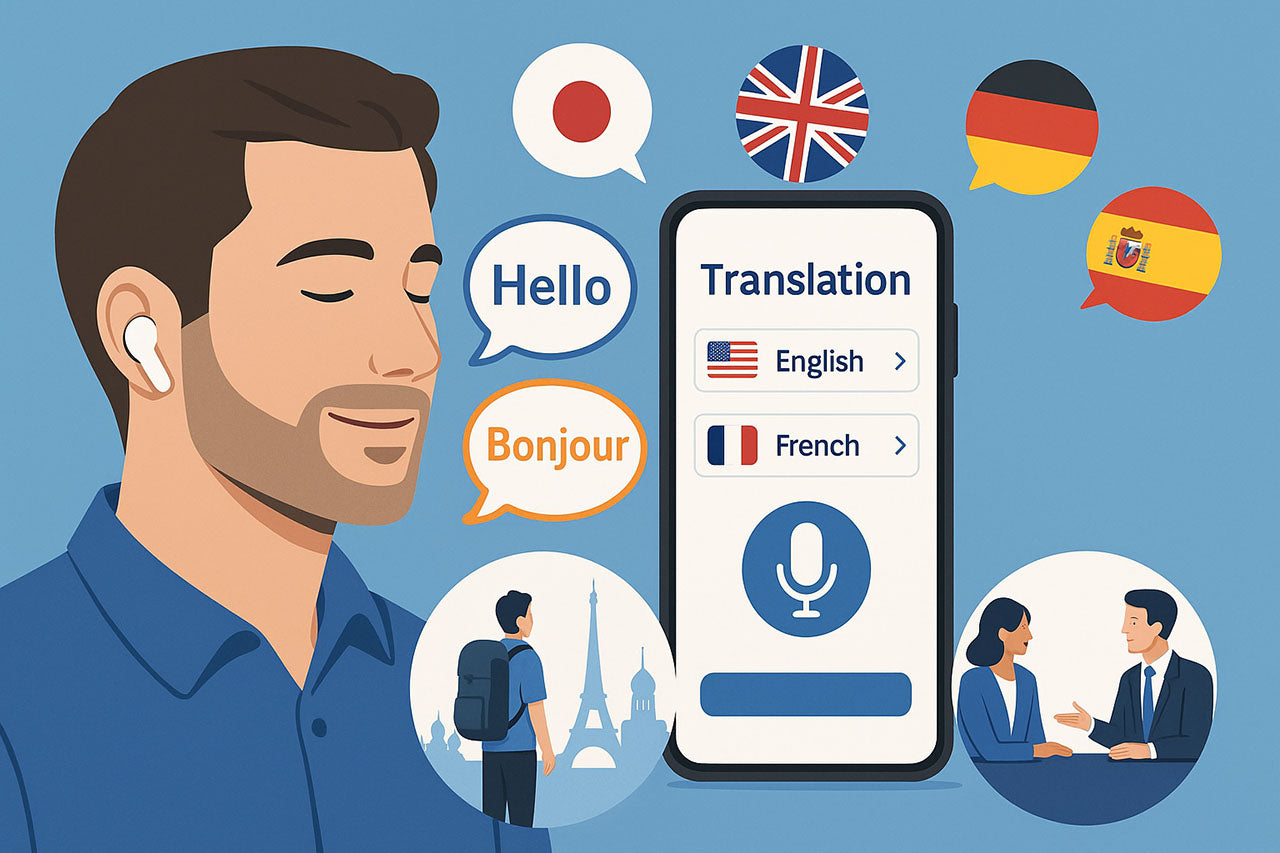AI translation earbuds are a portable device that integrates speech recognition, machine translation, and speech synthesis, enabling users to achieve real-time or near-real-time bidirectional voice translation while wearing them.
Their core components include a multi-microphone array (responsible for capturing user speech), a built-in AI translation chip (handling audio preprocessing and translation computation), a speaker or bone conduction module (playing the translated output), and a companion mobile app (used for selecting language pairs, viewing translation history, firmware updates, and other settings).
From a technical standpoint, these devices typically support 40–100 languages and various dialects or accents. In a good network environment, they rely on online servers to deliver high-precision translation with latencies around 200–500 milliseconds. When offline, they leverage an internal, limited phrase database to perform basic translations, although accuracy is somewhat lower. Additionally, the earbuds use a multi-microphone array combined with DSP noise reduction algorithms, ensuring accurate speech recognition even in noisy environments.
In terms of form factor, most models are true wireless TWS (in-ear), neckband, or ear-hook styles, while some also offer semi-in-ear or bone conduction designs to accommodate both calling and translation. Single-use battery life generally falls between 4–6 hours (higher power consumption when translating), and the accompanying charging case can provide 2–3 additional full charges. Fast-charging capabilities allow several hours of use after just 15 minutes of charging. The companion app handles language pair selection, translation history review, noise reduction and volume adjustment, firmware upgrades, and more. Some manufacturers even support cross-device syncing and cloud-based phrase database updates.
Practical Applications
In practical scenarios, the value of AI translation earbuds becomes very clear. For travelers going abroad—especially Japanese tourists visiting Europe, North America, or Southeast Asia, where the language environment is entirely different—wearing these earbuds allows seamless communication with locals at hotel reception desks, restaurants during meal orders, or at tourist attractions, without having to pull out a phone. When asking for directions on subways, buses, taxis, or streets, users can simply speak through the earbuds. In certain Asian or Middle Eastern markets where bargaining is common, these earbuds enable more confident price negotiations and clearer understanding of local replies.
For international business professionals, the earbuds eliminate the need for professional simultaneous interpreters at overseas trade shows; sales representatives can simply wear the earbuds to hear the other party’s language in real time and respond immediately. During remote video conferences—where even built-in translation features in conferencing software may suffer from lag or inaccuracies—the earbuds can broadcast translated speech inside the ear, reducing misunderstandings. This is especially useful for impromptu or small-scale, multi-language meetings. In face-to-face contract signings or negotiations, both parties can hear real-time translations through the earbuds, ensuring all key points and clauses are clearly understood, thereby minimizing commercial risks.
For students studying abroad, translation earbuds can solve everyday language barriers—opening a bank account, getting a mobile SIM card, signing a rental agreement, and so on. In lectures, earbuds equipped with recording functionality can translate a professor’s speech in real time into the student’s native language and save the transcript in the app for later review. Some products even offer a “conversation practice” mode, where users can engage in simulated dialogues with the system and receive pronunciation correction suggestions, which is particularly helpful for beginners.
Tour operators and guide services also benefit: they can equip multiple tourists with translation earbuds, allowing tour commentary to be instantly translated into visitors’ native languages (e.g., Chinese, Korean, English), thus broadening service coverage and improving efficiency. For customized tours, travelers can set Chinese, Japanese, English, or other preferred languages in the mobile app.
Binding and QR Codes
Whether using the earbuds themselves or relying solely on a mobile translation app, there are important differences in binding and authorization mechanisms. Most translation devices (earbuds, translation pens, etc.) ship with a dedicated QR code. This code corresponds to the device’s unique ID on the manufacturer’s server and is used to bind the hardware chip to the user’s account in the mobile app. The binding process typically goes as follows: download the official brand app from your app store → open the app and select “Scan Device QR Code” or “Enter Serial Number” → scan the QR code on the earbuds or packaging → the server verifies the device and completes the binding. Only after binding is successful will the app authorize the chip in the device to access translation algorithms and firmware updates.
Translation App Models and Integration
Most translation apps on the market—including those provided by earbud manufacturers—offer basic online translation features for text, voice, and photo input at no charge. Users need only be online to leverage cloud-based translation engines. Some apps also provide free offline translation packs, though with limited vocabulary and fewer supported languages. If you require stable offline translation, specialized terminology packs (such as medical, legal, or technical dictionaries), an ad-free experience, or advanced features like pronunciation assessment and correction, you will likely need to purchase a membership or additional offline packs. For ordinary travelers or students, free online translation services satisfy most day-to-day needs.
However, business travelers or tour guides who need high-volume, high-precision, and extended-duration real-time translation may choose to invest in a mid-to-high-end translation earbud model and its OEM app, or consider paid services from dedicated translation apps that offer minute-based packages or specialized terminology libraries. Decisions should be made based on budget and usage frequency.
The tight integration between translation earbuds and the companion app is due to the earbuds’ built-in AI translation chip, which handles audio capture, preprocessing, and noise reduction. The chip sends audio to the mobile app via Bluetooth or Wi-Fi; the app then calls either cloud or local translation engines and returns translated speech for the chip to synthesize and play back to the user.
Only after the device is bound—which authorizes the chip with the app’s translation algorithms—can this workflow function. Without binding, even if the app is installed and the user wears ordinary Bluetooth earbuds, no translation can take place because the app cannot detect the required hardware ID and won’t activate the translation feature. If the earbuds are lent to someone else who hasn’t bound them in their own app, they won’t translate. Likewise, when switching phones, the user must rescan the same QR code and complete verification; otherwise, the app will display “No device detected” and translation remains locked. Therefore, users must keep the QR code and binding information safe. When choosing a brand, opt for those that explicitly offer “device re-bind” or “QR code recovery” services to avoid future difficulties if the app is deleted, the phone is replaced, or you purchase secondhand.
VoIP Call Translation
Recently, some translation apps have added live translation support for WhatsApp and other VoIP calls. The method typically involves users granting “call recording” and “background microphone” permissions to the app. When a WhatsApp call begins, the app secretly captures both parties’ audio in real time and streams it to a translation server. The translated text and synthesized speech are then presented on the screen and played via the earbuds. This means the person on the other end hears the user’s native language (e.g., Chinese), while the user hears the translated version of the remote speaker’s voice. This two-way call translation feature requires no extra hardware—just the phone app—and is particularly useful for international remote customer service, remote interviews, or cross-border sales.
However, it depends on a stable internet connection to avoid audio packet loss, translation delays, or dropped calls. Moreover, some countries restrict call recording, and WhatsApp may block apps that perform background recording. Users must ensure compliance with local laws. Free versions of these apps often limit the number of minutes you can translate, requiring subscription upgrades for unlimited use or additional languages.
Purchase Considerations
Finally, when selecting translation earbuds, pay attention to these points:
-
Keep and back up your device’s QR code to avoid losing the ability to rebind.
-
Understand the app’s paid features to determine if free functions meet your needs.
-
If you’ll be using it frequently offline, choose a brand with robust, regularly updated offline translation packs.


Share:
Breaking Language Barriers: Unlock a New Era of Communication
How to use M62 translator earbuds